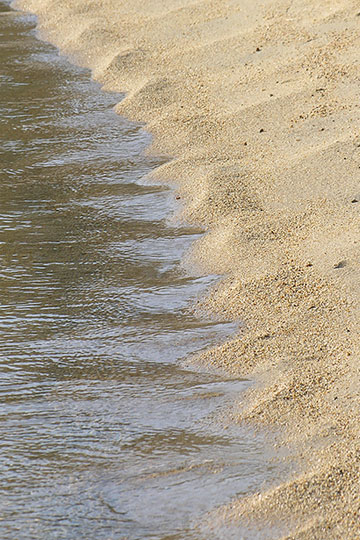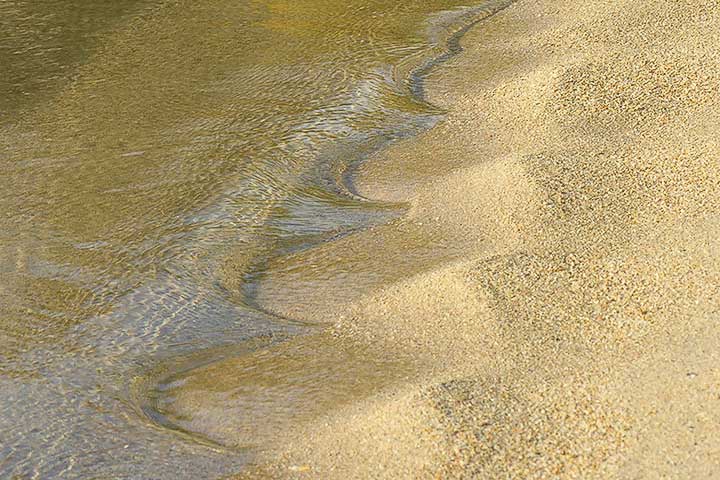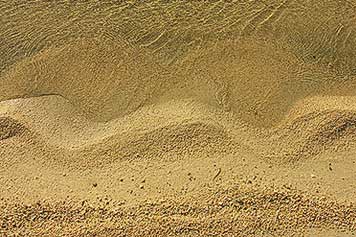Beach cusps
Surely the most delightful natural formation along the water’s edge is a collection of beach cusps: a rhythmic pattern of small cusps and bays. So pleasing are they that I modify my usual practice of walking along the wet sand merely so I won’t sully the pattern. So, under what circumstances does this pattern develop, and what is its explanation?
 Beach cusps form naturally, but uncommonly along the water’s edge.
Beach cusps form naturally, but uncommonly along the water’s edge.
Beach cusps seem to form best when the beach is steep, and regular non-breaking waves arrive nearly at right angles to the beach. The water which rushes up the beach is called the swash; the distance between the highest and lowest position of the swash front is called the swash length. It is this distance and the beach slope which determine the spacing of the cusps.
The explanation for beach cusps has undergone considerable debate of late. The question has been whether the pattern is imposed on the beach by (what is called) edge waves in the water along the shoreline, or whether it creates itself by (what is called) self-organising feedback. Most of the recent experimental work seems to support self organization. If this proves correct, then beach cusps join a wide range of other processes—from geophysics, chemistry, physics, biology, sociology—where self organization is involved in creating order.
A qualitative version of self organization starts with a fairly uniform beach. If at one spot, the velocity of the swash is slightly less, either because of wave interference or even a pebble or stick on the beach, then that portion of the swash will drop some of the larger sand grains. This only enhances the slow down for the next wave, which also drops some of its sand. So, a small promontory is built which slows and deflects subsequent waves. The portion of the swash which is deflected to either side of this growing cusp swings around in an arc and creates the bays. Now, those bays cause velocity differences which produce the next cusp, and so on down the beach.
 Beach cusps form preferentially when a regular series of non-breaking waves washes up on a steep beach.
Beach cusps form preferentially when a regular series of non-breaking waves washes up on a steep beach.
This picture shows cusps of water extending toward the cusps of sand. Until I watched closely, I had guessed that this pattern must occur during the backwash; after all, as the wave approaches the shore, it has a straight front. Yet, those points are indeed part of the swash (the wave flowing up the beach).
The clue to how this happens is found in the backwash of the previous wave. The water flowing into the little bays has farther to go than the water approaching the sand cusps. The backwash from the bays is delayed so much that it impedes the next wave approaching the bays. But, the portion of that wave approaching the cusps of sand is not similarly impeded and so it rushes ahead to produce cusps of water which kiss the cusps of sand.
 Very often the cusps are formed from the courser sand grains. As the swash approaches the cusp and is slowed, it can no longer carry the biggest grains and they are dropped.
Very often the cusps are formed from the courser sand grains. As the swash approaches the cusp and is slowed, it can no longer carry the biggest grains and they are dropped.
 The cuspate pattern extends under the water. The sand carved from each bay is carried by the backwash to form a small delta.
The cuspate pattern extends under the water. The sand carved from each bay is carried by the backwash to form a small delta.
 The water level has been dropping so that the beach cusps formed on a previous day are slightly higher on the beach than those forming at present. It is interesting that the two have a different spacing, presumably as a result of the difference in the waves on the two days.
The water level has been dropping so that the beach cusps formed on a previous day are slightly higher on the beach than those forming at present. It is interesting that the two have a different spacing, presumably as a result of the difference in the waves on the two days.
![]()